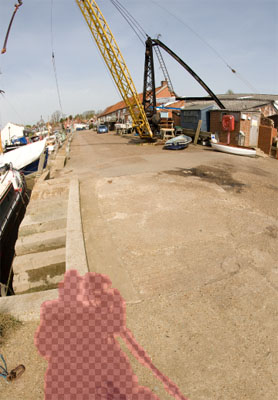In some images within a panorama set, there are usually elements that must be excluded from the final panorama - such as the legs of the tripod or the photographer's feet. This can be achieved by masking out the unwanted areas of each image before attempting to create a panorama.
 The masking process simply tells the software to ignore appropriately defined areas of images and any control points placed within them. However, if the same area is masked out of overlapping images it may prove impossible to complete the panorama, and gaps may appear where no information is available for inclusion.
The masking process simply tells the software to ignore appropriately defined areas of images and any control points placed within them. However, if the same area is masked out of overlapping images it may prove impossible to complete the panorama, and gaps may appear where no information is available for inclusion.
In a typical situation, the legs of the tripod may be visible in several images. The offending areas must therefore be masked out of the panorama and replaced by areas captured within the nadir image. Some software packages allow a positive masking option, which forces the image blender to incorporate a particular area of an image in the panorama. Similar problems may arise in images incorporating movement. Cars or people may appear twice in the same panorama, or may be cut in half at the boundaries used in the blending process. Masking must then be used to eliminate either one instance of the duplicated object, or remove the split object entirely.
In the image on the right, the shadow of the photographer and one of the tripod legs can be seen on the ground, and has been masked out of the blending process by painting the area pink with a masking brush tool.






